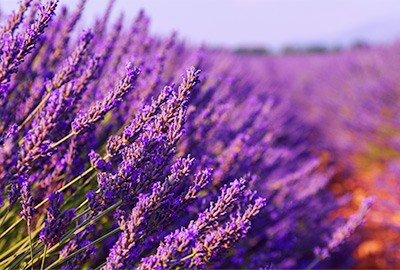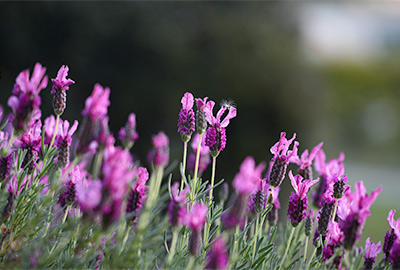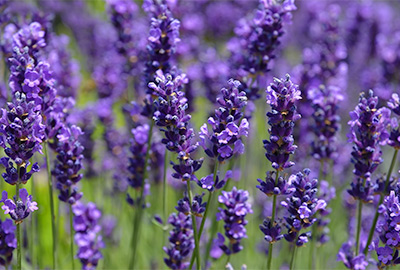Recommended Varieties/Cultivars
Most varieties of commonly available lavender do well in the warm Mediterranean climate of much of California, including English Tall, French, and Spanish Lavenders. French Lavenders, Canary Island Lavenders, and Fernleaf Lavenders may bloom almost year-round and many other varieties have long or repeat blooming periods.



Buying/Selection Tips
If you are interested in a specific cultivar or want blooms soon or immediately, GardenZeus recommends purchasing plants; however, confused labeling and naming of lavenders is a persistent issue among gardeners and at nurseries. This may be the result of there being so many different varieties of lavender, including many hybrids, and because many lavender species and hybrids readily cross and volunteer from seed. If you are interested in a specific variety, ask questions to confirm that the plants were propagated vegetatively or by cuttings from reliable nursery stock, and be prepared to recognize primary identifying features to confirm that you have the right variety when purchasing.
When buying plants, tap the edges of pots or containers to look at roots. Some visible roots or a fine net of roots at the edges of rootballs are acceptable; overgrown, layered, or circling roots at pot edges and bottoms indicate a rootbound plant that has been in the pot too long. This is not desireable and may result in a stunted, slow-growing, or disease-prone adult plant.
Soil Needs/Tip
Lavender's critical need is for well-drained soil that dries out between waterings. It otherwise often thrives in difficult locations with poor to moderately fertile soil. Most lavenders tolerate the slightly to moderately alkaline soils that are common in your area.
Suitable Microclimate
Lavenders prefer full sun, and may become leggy in part sun or bright shade. It does not survive well in soil that is constantly moist or that does not dry out between waterings.
Getting Started
Lavenders are best planted from late fall through spring in mild winter areas of California. Nursery selection in these areas may be greatest from January through March.
Lavenders tend to be somewhat variable from seed, even for recognized cultivars, which may or may not be desirable to any individual gardener. Lavenders can also be somewhat difficult from seed. Seeds need a light soil mixture, and may rot if kept constantly moist during the 2 weeks or longer that are often needed for germination. Lavender may take 6 months to a year or longer after germination to produce blooms; if interested in blooms quickly, consider varieties that are grown as annuals. Unlike many highly desired flowering perennials, mass plantings and large swaths of lavender are possible inexpensively from seed with effort and practice.
Watering Tips
Lavender needs regular watering during establishment, with periods of dryness between waterings. Inappropriate watering, such as with sprinklers, is the primary reason for death of adult lavender plants. The critically important tip for watering lavender is to avoid wetting the root crown (the area where the top of the roots meets the bottom of the stem), and particularly avoid keeping the root crown moist for any period of time. When possible, water at the edges of the lavender plants' root systems rather than wetting the root crown or soaking the entire root zone. For established lavender plants, judicious watering should be combined with good drainage in moderately fertile soil that dries out between waterings.
Planting Method/Tips
To encourage good drainage and avoid dampness at lavender root crowns, GardenZeus recommends mounding lavender slightly when planting or transplanting so that the root crown sits above grade in the ground or in pots, especially in areas that may have prolonged periods of moisture from rain or irrigation, and especially in clay soils. Planting lavender as slightly raised may make the difference between plants that thrive and those that succumb to soil fungi and root rots.
When planting from nursery pots, remove the plant from the pot and gently remove excess soil at the top and bottom of the root ball. Whenever possible, prevent soil from falling entirely off the rootball, as this may shock or kill the plant. Most lavenders should be planted and mounded with the root crown 2 to 3 inches above grade, in a hole no deeper than each plant's actual rootball. Do not dig a hole deeper than the plant's rootball or disturb soil at the bottom of the hole, as the plant may sink below grade when loose soil beneath roots settles over time, which may result in lifelong stress and ongoing pest and disease problems for the life of the plant. Before planting, prune out any dead or broken stems, and cut off girdling, circling, matted, or dead roots, leaving roots that can be spread with a few inches of spacing between them in the planting hole.
Spacing
Variable by type. May be less than a foot for miniature varieties to 3 to 4 feet or more wide and high for larger varieties.
Timelines
10 to 30 days for seed germination.
4 to 20 weeks from germination to transplant for most types of lavender.
3 months to a year or longer from germination to blooming for most types of lavender.
Pollination Needs/Tips
As most gardeners are interested in lavender blooms or foliage, little concern is generally paid to lavender pollination. Many lavender varieties may produce viable seeds, which may occasionally produce volunteers or be germinated and grow into plants that may or may not differ significantly from their parents.
Interplanting/Companion Planting
Lavender is a famous attractor of honey bees, bumblebees, and some species of solitary bees, as well as other pollinators and beneficial insects, and may be planted in dry borders or in well-drained pots near vegetable gardens or fruit trees to encourage pollination of other plants. Lavender generally should not be interplanted in close proximity to vegetables, as the soil moisture conditions required for healthy vegetables may be fatal to lavender.
Nutrient/Amendment/Fertilization Needs/Tips
Lavenders prefer moderately fertile, slightly allkaline soil for establishment. Once established, they require little or no fertilization beyond minimal addition of compost and/or mulch away from the root crown two or three times per year.
Mulching
GardenZeus recommends bare soil with no mulch in a radius of a few to several inches from lavender main stems and root crowns, and minimal organic mulch at the surface above the remaining area of lavender root zones, from just inside the dripline outward for larger plants. Organic mulch is recommended only if kept away from the stem and root crowns can be kept dry. Even inorganic mulches, such as gravel or stones, may contribute to fungal disease in lavenders if applied near root crowns or main stems.
Pruning/Cutting Back/Pinching/Separating
In general, lavenders need frequent, somewhat aggressive pruning, pinching back, and harvest to maintain an attractive, compact form and avoid becoming leggy. Prune more aggressively after blooming, especially in late fall or over winter for shape, and from spring to fall for general cleanup and removal of spent blooms. Lavenders bloom on the current season's growth. Use caution when pruning or pinching back before lavenders have bloomed, especially in spring and late summer or early fall; for some varieties you may inadvertantly reduce or eliminate blooming by pinching back or pruning aggressively. If grown from seed, GardenZeus recommends pinching off any new flower buds from perennial lavenders for the first 6 months to a year to encourage more vegetative growth and more vigorous plants to increase later blooming and harvest.
Propagating
Lavenders are commonly propagated via seeds, layering, and cuttings.
To propagate by layering, bend a low-growing stem to the ground or a planting pot and abrade or scrape gently to expose cambium on the side of the stem that will be in contact with soil, preferably on slightly woody growth near greener stem tips. Pull the abraded section to the soil surface, cover with fertile soil or compost, and weigh down with a stone or brick. Water every few days or often enough to keep slightly moist but allow partial drying between waterings. When roots develop, cut the stem below the roots. A few weeks later after the new plant has established, remove and pot up or transplant.
Most lavenders propagate best from cuttings of new growth in spring before blooming or during cool weather in fall from cuttings of nonwoody stems that that have not bloomed. Remove most leaves from the cuttings, leaving only 2 to 3 leaves at the top or growing tip of the cutting. Plant numerous cuttings into each 6-inch or 1-gallon pot in sand and/or vermiculite, and keep in the brightest possible light away from direct sunlight. Water after planting cuttings, then occasionally thereafter, keeping the soil medium slightly moist. Maintaining an appropriate moisture content in soil is important for rooting lavender: too much dampness and wetness, and the cuttings are prone to rotting before they root; too little, and they may dry out and die before rooting.
Container Gardening
Lavenders generally prefer or tolerate somewhat constricted root zones, and often are healthiest when their rootballs encompass most soil in a container, but roots are not yet severely restricted or circling inside pots. Tight rootballs help lavender plants to maintain dryness in their root zones, naturally preventing persistently wet or boggy areas in pots, which can be lethal to lavender.
Most commonly available lavenders, including English and Spanish Lavenders, do well in containers in many portions of California. Larger varieties, including many Lavindins and French Lavenders, will tolerate being rootbound to a point, but may be more prone to pest and disease problems or have shortened lives in containers.
Seasonal Care
Lavenders are best planted from late fall through spring in mild winter areas of California. Many varieties have long blooming periods beginning spring or early summer, and some varieties, including French Lavenders, Canary Island Lavenders, and Fernleaf Lavenders, may bloom almost year-round in some portions of California. Plants may need to be cut back aggressively after blooming or over winter to avoid legginess and maintain a compact, attractive form. Maintain a low-fertility organic mulch away from the stems of lavender, and prune, trim, pinch back, and clean up plants frequently, especially after periods of blooming. Established lavender plants are often otherwise relatively maintenance free.
How to Harvest
Harvest for crafts, cooking, and medicine as soon as possible after lavender flowers open, when fragrance and essential oils will be at their strongest. Flower spikes may be harvested while half or more of the individual blooms are still unopened. Use a sharp harvesting knife, garden knife, or pruning shears to cut flower spikes individually or in bunches. You may wish to prune off inflorescences below the cut that will die back naturally after harvest and may give the plant a messy or unhealthy appearance. Because lavenders are prone to becoming leggy and messy in appearance, GardenZeus recommends light pruning when harvesting for shaping and to remove dead material.
Harvesting Tips
Lavender spikes can be harvested as cut flowers and displayed in vases without water.
What Commonly Goes Wrong
Overwatering: Water issues are the primary reason for expired or unhealthy lavender plants. Avoid wetting root crows, and allow soil to dry between waterings.
Poor drainage: Soils are often compacted below the surface, and damp, anaerobic pockets may persist belowground when soil is dry at the surface. Lavender plants require good drainage, whether in the ground or in a pit, with some species and varieties being more sensitive than others. Mound plants at planting and reduce watering.
Not a Problem
Many lavenders are short-lived, and may die naturally after 3 to 6 years.
Common Diseases
Root rots are the most common disease problem with lavender in most portions of California. Plants may appear sickly with yellowing or discolored leaves, wilting, dead and dying leaves and stems. Lavender plants may die quickly, almost suddenly, with most of their leaves still on the plant, once infected with a root rot. Lavender requires good drainage and a drying-out period between waterings.
Common Pests
Lavender is a relatively pest-free plant in the temperate, Mediterranean climate of much of California; if you have anything but occasional, mild pest infestations, you may have a deficiency or toxicity in your soil, or other environmental issues causing stress to the plants.
Insect pests of lavender include spittle bugs, aphids, and white flies. Lavender may also attract yellow jackets and hornets, which are not pests of the plant, but might be of concern, particularly in households with children and animals.
Spittle bugs, which appear as spit-like gobs throughout the plant, are usually easily removed with a strong stream of water, and usually do not cause lasting damage or kill lavender plants. Aphids may also be removed with a strong stream of water. Persistent aphid infestations may be associated with Argentinian Ant infestations; control ants with a boric-acid ant bait. White flies may be more difficult to control: minor infestations can be removed by hand using rags or paper towels dampened in diluted horticultural soap or rubbing alcohol; severe white fly infestations may be difficult to control and are likely a secondary result of environmental stress.
Special Care
Lavender plants are ideal for much of California, and with minimal planning, appropriate placement, and care with watering, can go on for years with few problems. Avoid planting in fertile or rich soil, or in areas with poor drainage or where watering cannot be controlled, such as at the edges of lawns or other areas watered by sprinklers.
Special Info
Lavender flowers can be used as a flavoring herb, particularly for infusing sugar; in baking and breadmaking; for herbal and medicinal tea; and in syrups, dressings, and sauces. Fresh flowers make a striking addition to salad. Flowers, buds, leaves, and stems are all edible and used both fresh and dried. To dry lavender flowers see Drying Fresh Herbs and Flowers
If you wish to cook with lavender, choose your varieties carefully in advance of planting. English Lavender is typically used for cooking, with flowers that are mild and sweet; select cultivars that are known to be suitable for cooking, and if possible obtain flowers from multiple varieties to taste and cook with in advance to make an educated choice about which you prefer before planting. Be cautious with harvesting flowers from plants in public areas or in any area in which you don't know the maintenance history, as plants or soil may have been treated with pesticide or other chemicals. Lavender can quickly become overpoweringly perfumey or bitter in food, so use with caution. Many landscape and garden species and varieties of lavender may be unsuitable for culinary use.
Sustainable Landscaping Tip
Many varieties of lavender are idea for low-water, beautiful-but-sustainable landscaping in many portions of California. They fulfill an unusually broad range of functions in the landscape, particularly in providing food to beneficial insects and in offering beauty, fragrance, and medicine to people. Many lavenders continue blooming in late summer or fall, providing food for beneficial insects when other food sources are less abundant.
Advanced Tip
The word "lavender" may be derived from the Latin "lavare," the verb "to wash," which hints at the plant's longtime use as a bathing infusion. For a medicinal, fragrant bath, run very hot water and infuse about 1 cup of dried lavender flowers or 2 cups of fresh flowers (or to preference) for about 10 to 30 minutes until the water cools enough to bathe in. Use a large "teabag" made of mesh, cheesecloth, or coarse fabric if you prefer to avoid having flowers floating around in the water while bathing. For a more complex and nuanced flower bath, add rose petals, rosemary leaves, mint, or other aromatic herbs and flowers.
Preservation, Storage, and Use
Once harvested, avoid packing stems tightly in vases, which will allow them to dry naturally. Lavender flowers remain fragrant and attractive, and may be kept on display for extended periods of time, although they may be a bit messy as they drop fine dried petals over time. Lavender flower are traditionally dried in tied bunches hanging upside down in a cool, dark, dry place. Store away from light, heat, and humidity.
Lavender is not sensitive to ethylene gas produced by fruits.
Lavender flowers can be used as a flavoring herb, particularly for infusing sugar; in baking and bread making; for herbal and medicinal tea; and in syrups, dressings, and sauces. Fresh flowers make a striking addition to salad. Flowers, buds, leaves, and stems are all edible and used both fresh and dried.
If you wish to cook with lavender, choose your varieties carefully in advance of planting. English Lavender is typically used for cooking, with flowers that are mild and sweet; select cultivars that are known to be suitable for cooking, and if possible obtain flowers from multiple varieties to taste and cook with in advance to make an educated choice about which you prefer before planting. Be cautious with harvesting flowers from plants in public areas or in any area in which you don't know the maintenance history, as plants or soil may have been treated with pesticide or other chemicals. Lavender can quickly become overpoweringly perfumey or bitter in food, so use with caution. Many landscape and garden species and varieties of lavender may be unsuitable for culinary use.
Lavender can also be used in oils, soaps, sachets and perfumes.
The word "lavender" may be derived from the Latin "lavare," the verb "to wash," which hints at the plant's longtime use as a bathing infusion. For a medicinal, fragrant bath, run very hot water and infuse about 1 cup of dried lavender flowers or 2 cups of fresh flowers (or to preference) for about 10 to 30 minutes until the water cools enough to bathe in. Use a large "teabag" made of mesh, cheesecloth, or coarse fabric if you prefer to avoid having flowers floating around in the water while bathing. For a more complex and nuanced flower bath, add rose petals, rosemary leaves, mint, or other aromatic herbs and flowers.